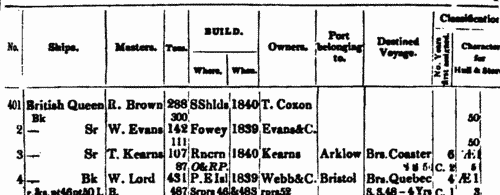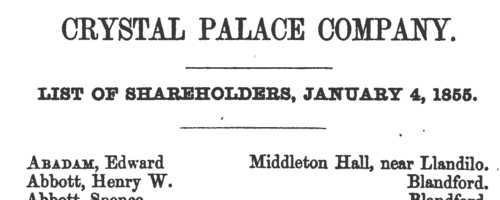Simmins Surname Ancestry ResultsOur indexes 1845-1865 include entries for the spelling 'simmins'. In the period you have requested, we have the following 5 records (displaying 1 to 5): Buy all | | | Get all 5 records to view, to save and print for £32.00 |
These sample scans are from the original record. You will get scans of the full pages or articles where the surname you searched for has been found. Your web browser may prevent the sample windows from opening; in this case please change your browser settings to allow pop-up windows from this site. Masters of Merchantmen
(1852-1853)
Lloyd's Register of British and Foreign Shipping was issued annually, listing ships that had been surveyed preparatory to being insured. This is the register issued 1 July 1852 and then annotated as ships were re-surveyed through to 30 June 1853. The ships were numbered by the first letter of their name, and then by number alphabetically through the ships' names and within ships of the same name alphabetically by surname of the master. After the name of the ship there is the type of vessel (Bk, barque; Bg, brig; Bn, brigantine; Cr, cutter; Dr, dogger; G, galliott; H, hoy; K, ketch; Lr, lugger; Pol, polacre; S, ship; Sk, smack; Sp, sloop; Sr, schooner; St, schoot; Stm, steamer; Sw, snow; Yt, yacht), master's name (as at the time of the last survey); tonnage; place and year of build; owners; port belonging to; destined voyage; number of years first assigned; and character for hull and stores (e. g., A 1), with the year or month (e. g., 50 for 1850, or 2 for February 1852) of inspection. Underneath some entries details were given of construction and repair, with year - s., sheathed; d., doubled; C., coppered; I. B., iron bolts; c. f., copper fastened; M., sheathed with marine metal; Y. M., sheathed with yellow metal; G., sheathed with galvanised iron; Z., sheathed with zinc; F., felt; C. lm., coppered to light water or ballast mark; C. T., copper bolts substituted for treenails; Cl., clincher; len., lengthened; lrp., large repairs; trp., thorough repairs; Drp., damage repaired; ND., new deck; N TSds., new top-sides; W. C., wales cased; NW., new wales; NB., new bottom; NK., new keel; plk, Plank; N Klsn, new kelson; alm. rb., almost rebuilt; pt O. M., part old materials (timbers or plank); Srprs, some repairs - and, in italics, the timber of the ship is described - A, ash; B B, black birch; Bh, beech; C, cedar; E, elm; F, fir; G, gum; Ght, greenheart; Hk, hackmatack; Hm, hemlock; L, locust; Lh, larch; L O, live oak; M, mahogany; P, pine; P P, pitch pine; R P, red pine; Y P, yellow pine; S, spruce; T, teak; Tam, tamarac; W H, witch hazel; W O, white oak. The sample scan is from the main list. The third column, reserved for masters' names, is not particularly wide; with short surnames, an initial will be given; but longer surnames omit the initials, and even longer surnames are abbreviated. This is the index to masters in the main list. Often new masters had been appointed by the time of re-survey, and their names are added in slightly smaller type under the original master's names in the third column. These new masters are also included in this index. It should be borne in mind that the masters in the main list are those at the time of the respective previous survey for each ship, not necessarily as of 1 July 1852.SIMMINS. Cost: £6.00.  | Sample scan, click to enlarge

| Crystal Palace Company Shareholders
(1856)
The management of the Crystal Palace, built for the Great Exhibition of 1851, was restructured by a Deed of Settlement in 1852, and then incorporated as the Crystal Palace Company by royal charter in January 1853. This alphabetical list of shareholders was published in January 1856.SIMMINS. Cost: £4.00.  | Sample scan, click to enlarge

| Schoolmasters and trainees with Certificates of Merit
(1856)
The Committee of Council on Education for England and Wales produced an annual report which included several lists of teachers and trainee teachers, including an Annual Calendar of Teachers who have Obtained Certificates of Merit (completed to 1 January 1856), from which this sample scan is taken. The teachers are listed alphabetically by surname and initial, with name of school, post town or county, and grade, as either certificate or class. Student teachers were classed at the end of each year of training, so the column for class shows a student's class (1, 2 or 3) at the end of their first or second year of training. The teacher may then be awarded a certificate of merit by Her Majesty's Inspector, in which case the class and division of the certificate awarded appears in the columns for Certificate. No certificate of merit was granted a student, as a teacher, until he or she had been for two years in charge of the same elementary school, and the certificate was granted on the basis of two reports of performance as a teacher in school. If the first report was favourable, the teacher was paid for the first year on the scale of the lowest class; if the second report was favourable, augmentation and class of certificate was fixed for the next five years, after which (and so on from time to time) the certificates were open to revision. The value of the certificate, in the first instance, was not fixed higher than the first division of the third class, for any student who had resided less than two years at a training school under inspection. This is the index to the schoolmasters and male students in training schools. SIMMINS. Cost: £6.00.  | Sample scan, click to enlarge

|  Persons of standing recommending London police recruits
(1843-1857) Persons of standing recommending London police recruits
(1843-1857)
The Metropolitan Police Register of Joiners (MEPO 4/334) lists policemen joining the force 1 January 1843 to 1 April 1857 (warrant numbers 19893 to 35804). The register is alphabetical, in so far as the recruits are listed chronologically grouped under first letter of surname. It gives Date of Appointment, Name, Number of Warrant, Cause of Removal from Force (resigned, dismissed, promoted or died), and Date of Removal. Although the register was closed for new entrants at the end of 1842, the details of removals were always recorded, some being twenty or more years later. Those recruits not formerly in the police, the army, or some government department, were required to provide (normally) at least two letters of recommendation from persons of standing, and details of these are entered on the facing pages. Where a recruit was only recently arrived in the metropolis, the names and addresses of the recommenders can be invaluable for tracing where he came from. Those recruits not formerly in the police, the army, or some government department, were required to provide (normally) at least two letters of recommendation from persons of standing, and details of these are entered on the facing pages: the names in these are indexed here (the police recruits are indexed separately and not included here). Recruits transferred from other forces or rejoining the force did not normally need recommendations - in the latter case, former warrant numbers are given - but some recommendations are from police inspectors, even other constables. Recruits coming from the army sometimes have general military certificates of good conduct, but most often have a letter from their former commanding officer; recruits recommended by government departments (most often the Home Office) similarly have letters from the head of department. But the great majority of the names and addresses in these pages are of respectable citizens having some sort of personal acquaintance with the recruit. Where more than two recommendations were provided, the clerk would only record one or two, with the words 'and others'. Tradesmen are sometimes identified as such by their occupations; there are some gentry. Although the bulk of these names are from London and the home counties, a scattering are from further afield throughout Britain and Ireland. SIMMINS. Cost: £8.00.  | Sample scan, click to enlarge

|  Sailors and marines on board Her Majesty's ship Calcutta
(1856-1860) Sailors and marines on board Her Majesty's ship Calcutta
(1856-1860)
The China Medal was awarded to soldiers and sailors involved in the various actions of the war against China, in which this ship was engaged from 1856 to 1860. The medals were either delivered on board or sent on in 1862: except that many of the men were no longer immediately traceable, and the remarks on the roll show that some medals were not sent on for several years, and some were never sent. After the main roll there is a section showing which of the men also qualified for clasps. Separate clasps were awarded for men who had been in receipt of the China Medal of 1842; for the taking of Fatshan in 1857, Canton in 1857, Taku Forts in 1858, Taku Forts in 1860, and Pekin in 1860. Most of the men on this ship are shown as having been given the Fatshan clasp, for being actually present during the successful operations against the Chinese war junks in the Escapo creek, which commenced 25 May and were finally closed at Fatshan 1 June 1857; the Canton clasp, for being actually present at Canton on 28 and 29 December 1857, when that city was bombarded and finally captured; and the Taku Forts 1858 clasp, for being actually engaged in the operations which ceased with the first capture of the Taku Forts, 20 May 1858, and led to the Treaty of Tientsin.SIMMINS. Cost: £8.00.  | Sample scan, click to enlarge

|
Research your ancestry, family history, genealogy and one-name study by direct access to original records and archives indexed by surname.
|








